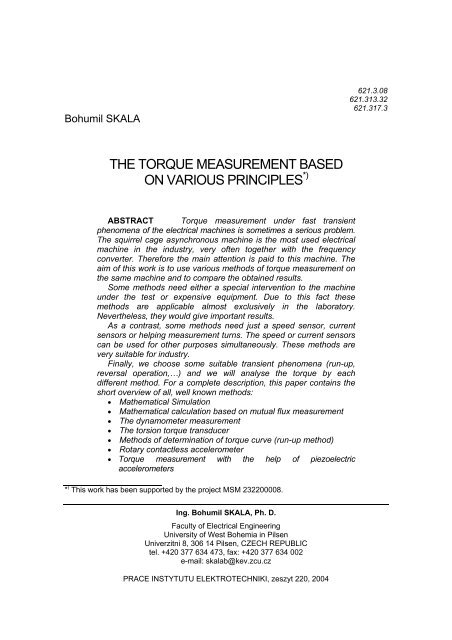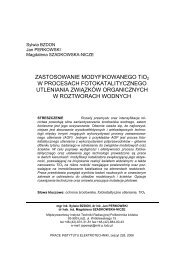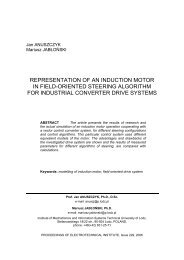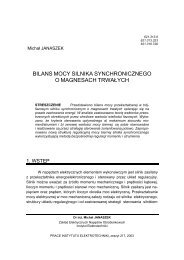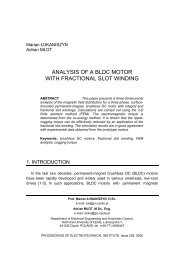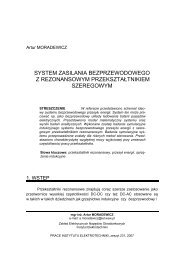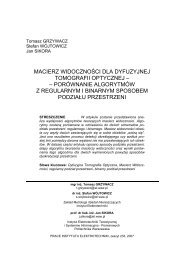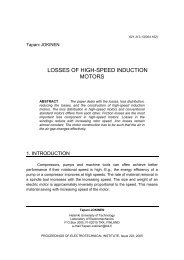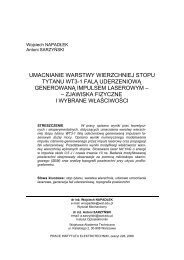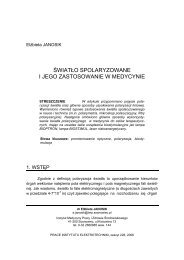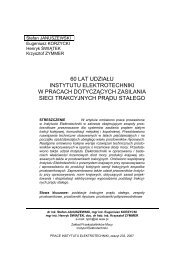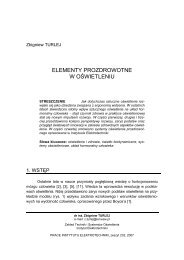the torque measurement based on various principles
the torque measurement based on various principles
the torque measurement based on various principles
Create successful ePaper yourself
Turn your PDF publications into a flip-book with our unique Google optimized e-Paper software.
Bohumil SKALA<br />
621.3.08<br />
621.313.32<br />
621.317.3<br />
THE TORQUE MEASUREMENT BASED<br />
ON VARIOUS PRINCIPLES *)<br />
ABSTRACT Torque <str<strong>on</strong>g>measurement</str<strong>on</strong>g> under fast transient<br />
phenomena of <str<strong>on</strong>g>the</str<strong>on</strong>g> electrical machines is sometimes a serious problem.<br />
The squirrel cage asynchr<strong>on</strong>ous machine is <str<strong>on</strong>g>the</str<strong>on</strong>g> most used electrical<br />
machine in <str<strong>on</strong>g>the</str<strong>on</strong>g> industry, very often toge<str<strong>on</strong>g>the</str<strong>on</strong>g>r with <str<strong>on</strong>g>the</str<strong>on</strong>g> frequency<br />
c<strong>on</strong>verter. Therefore <str<strong>on</strong>g>the</str<strong>on</strong>g> main attenti<strong>on</strong> is paid to this machine. The<br />
aim of this work is to use <strong>various</strong> methods of <str<strong>on</strong>g>torque</str<strong>on</strong>g> <str<strong>on</strong>g>measurement</str<strong>on</strong>g> <strong>on</strong><br />
<str<strong>on</strong>g>the</str<strong>on</strong>g> same machine and to compare <str<strong>on</strong>g>the</str<strong>on</strong>g> obtained results.<br />
Some methods need ei<str<strong>on</strong>g>the</str<strong>on</strong>g>r a special interventi<strong>on</strong> to <str<strong>on</strong>g>the</str<strong>on</strong>g> machine<br />
under <str<strong>on</strong>g>the</str<strong>on</strong>g> test or expensive equipment. Due to this fact <str<strong>on</strong>g>the</str<strong>on</strong>g>se<br />
methods are applicable almost exclusively in <str<strong>on</strong>g>the</str<strong>on</strong>g> laboratory.<br />
Never<str<strong>on</strong>g>the</str<strong>on</strong>g>less, <str<strong>on</strong>g>the</str<strong>on</strong>g>y would give important results.<br />
As a c<strong>on</strong>trast, some methods need just a speed sensor, current<br />
sensors or helping <str<strong>on</strong>g>measurement</str<strong>on</strong>g> turns. The speed or current sensors<br />
can be used for o<str<strong>on</strong>g>the</str<strong>on</strong>g>r purposes simultaneously. These methods are<br />
very suitable for industry.<br />
Finally, we choose some suitable transient phenomena (run-up,<br />
reversal operati<strong>on</strong>,…) and we will analyse <str<strong>on</strong>g>the</str<strong>on</strong>g> <str<strong>on</strong>g>torque</str<strong>on</strong>g> by each<br />
different method. For a complete descripti<strong>on</strong>, this paper c<strong>on</strong>tains <str<strong>on</strong>g>the</str<strong>on</strong>g><br />
short overview of all, well known methods:<br />
• Ma<str<strong>on</strong>g>the</str<strong>on</strong>g>matical Simulati<strong>on</strong><br />
• Ma<str<strong>on</strong>g>the</str<strong>on</strong>g>matical calculati<strong>on</strong> <str<strong>on</strong>g>based</str<strong>on</strong>g> <strong>on</strong> mutual flux <str<strong>on</strong>g>measurement</str<strong>on</strong>g><br />
• The dynamometer <str<strong>on</strong>g>measurement</str<strong>on</strong>g><br />
• The torsi<strong>on</strong> <str<strong>on</strong>g>torque</str<strong>on</strong>g> transducer<br />
• Methods of determinati<strong>on</strong> of <str<strong>on</strong>g>torque</str<strong>on</strong>g> curve (run-up method)<br />
• Rotary c<strong>on</strong>tactless accelerometer<br />
• Torque <str<strong>on</strong>g>measurement</str<strong>on</strong>g> with <str<strong>on</strong>g>the</str<strong>on</strong>g> help of piezoelectric<br />
accelerometers<br />
* ) This work has been supported by <str<strong>on</strong>g>the</str<strong>on</strong>g> project MSM 232200008.<br />
Ing. Bohumil SKALA, Ph. D.<br />
Faculty of Electrical Engineering<br />
University of West Bohemia in Pilsen<br />
Univerzitni 8, 306 14 Pilsen, CZECH REPUBLIC<br />
tel. +420 377 634 473, fax: +420 377 634 002<br />
e-mail: skalab@kev.zcu.cz<br />
PRACE INSTYTUTU ELEKTROTECHNIKI, zeszyt 220, 2004
18<br />
B. Skala<br />
The aim of this submissi<strong>on</strong> is to describe some suitable methods<br />
for <str<strong>on</strong>g>torque</str<strong>on</strong>g> <str<strong>on</strong>g>measurement</str<strong>on</strong>g>. The choice of <str<strong>on</strong>g>the</str<strong>on</strong>g> suitable method of<br />
<str<strong>on</strong>g>measurement</str<strong>on</strong>g> depends <strong>on</strong> <str<strong>on</strong>g>the</str<strong>on</strong>g> actual situati<strong>on</strong>, equipment and<br />
instruments that are at <str<strong>on</strong>g>the</str<strong>on</strong>g> hand.<br />
This work has been supported by <str<strong>on</strong>g>the</str<strong>on</strong>g> project MSM 232200008.<br />
1. INTRODUCTION<br />
Normally <str<strong>on</strong>g>the</str<strong>on</strong>g> performance of rotating drives is described by <str<strong>on</strong>g>torque</str<strong>on</strong>g> and<br />
rotati<strong>on</strong>al speed. In electrical machine practice we need a method of measuring<br />
accelerati<strong>on</strong> (or speed) and <str<strong>on</strong>g>torque</str<strong>on</strong>g> under widely different c<strong>on</strong>diti<strong>on</strong>s. Measuring<br />
of <str<strong>on</strong>g>the</str<strong>on</strong>g> rotati<strong>on</strong>al speed can be d<strong>on</strong>e accurately in many cases. The <str<strong>on</strong>g>torque</str<strong>on</strong>g><br />
<str<strong>on</strong>g>measurement</str<strong>on</strong>g> requires suitable equipment which is sometimes very expensive.<br />
It is possible to say that <str<strong>on</strong>g>the</str<strong>on</strong>g> following methods, which will be menti<strong>on</strong>ed<br />
here, are valid generally but some methods are designed especially for<br />
asynchr<strong>on</strong>ous machine <str<strong>on</strong>g>torque</str<strong>on</strong>g> <str<strong>on</strong>g>measurement</str<strong>on</strong>g>.<br />
The squirrel cage asynchr<strong>on</strong>ous machine is <str<strong>on</strong>g>the</str<strong>on</strong>g> most used electrical<br />
machine in <str<strong>on</strong>g>the</str<strong>on</strong>g> industry, very often toge<str<strong>on</strong>g>the</str<strong>on</strong>g>r with <str<strong>on</strong>g>the</str<strong>on</strong>g> frequency c<strong>on</strong>verter.<br />
Therefore <str<strong>on</strong>g>the</str<strong>on</strong>g> main attenti<strong>on</strong> is paid to this machine.<br />
The aim of this work is to use <strong>various</strong> methods of <str<strong>on</strong>g>torque</str<strong>on</strong>g> <str<strong>on</strong>g>measurement</str<strong>on</strong>g><br />
<strong>on</strong> <str<strong>on</strong>g>the</str<strong>on</strong>g> same machine and to compare <str<strong>on</strong>g>the</str<strong>on</strong>g> obtained results. The methods of<br />
<str<strong>on</strong>g>measurement</str<strong>on</strong>g> could be divided into two groups.<br />
Some methods need ei<str<strong>on</strong>g>the</str<strong>on</strong>g>r a special interventi<strong>on</strong> to <str<strong>on</strong>g>the</str<strong>on</strong>g> machine under <str<strong>on</strong>g>the</str<strong>on</strong>g><br />
test or expensive equipment. Due to this fact <str<strong>on</strong>g>the</str<strong>on</strong>g>se methods are applicable almost<br />
exclusively in <str<strong>on</strong>g>the</str<strong>on</strong>g> laboratory. Never<str<strong>on</strong>g>the</str<strong>on</strong>g>less, <str<strong>on</strong>g>the</str<strong>on</strong>g>y would give important results.<br />
As a c<strong>on</strong>trast, some methods need just a speed sensor, current sensors<br />
or helping <str<strong>on</strong>g>measurement</str<strong>on</strong>g> turns. The speed or current sensors can be used for<br />
o<str<strong>on</strong>g>the</str<strong>on</strong>g>r purposes simultaneously. These methods are very suitable for industry.<br />
Finally, we choose some suitable transient phenomena (run-up,<br />
reversing,…) and we will analyse <str<strong>on</strong>g>the</str<strong>on</strong>g> <str<strong>on</strong>g>torque</str<strong>on</strong>g> by each different method. For<br />
a complete descripti<strong>on</strong>, this paper c<strong>on</strong>tains <str<strong>on</strong>g>the</str<strong>on</strong>g> short overview of all, well known<br />
methods. The attenti<strong>on</strong> is paid to <str<strong>on</strong>g>the</str<strong>on</strong>g> latest case – <str<strong>on</strong>g>the</str<strong>on</strong>g> proposal of <str<strong>on</strong>g>the</str<strong>on</strong>g> <str<strong>on</strong>g>torque</str<strong>on</strong>g><br />
<str<strong>on</strong>g>measurement</str<strong>on</strong>g> thanks to piezoelectric accelerometers.<br />
2. MATHEMATICAL SIMULATION<br />
The ma<str<strong>on</strong>g>the</str<strong>on</strong>g>matical model is menti<strong>on</strong>ed here just for <str<strong>on</strong>g>the</str<strong>on</strong>g> sake of complexity.<br />
Several scientific books and research papers are devoted to <str<strong>on</strong>g>the</str<strong>on</strong>g> ma<str<strong>on</strong>g>the</str<strong>on</strong>g>matical
The <str<strong>on</strong>g>torque</str<strong>on</strong>g> <str<strong>on</strong>g>measurement</str<strong>on</strong>g> <str<strong>on</strong>g>based</str<strong>on</strong>g> <strong>on</strong> <strong>various</strong> <strong>principles</strong> 19<br />
model. The basic ma<str<strong>on</strong>g>the</str<strong>on</strong>g>matical model is very well known and <str<strong>on</strong>g>the</str<strong>on</strong>g> electrical and<br />
mechanical magnitudes as well can be easy calculated. Never<str<strong>on</strong>g>the</str<strong>on</strong>g>less, <str<strong>on</strong>g>the</str<strong>on</strong>g><br />
ma<str<strong>on</strong>g>the</str<strong>on</strong>g>matical model c<strong>on</strong>tains certain simplificati<strong>on</strong>s, i.e. <str<strong>on</strong>g>the</str<strong>on</strong>g> slot effect, magnetic<br />
circuit losses or skin-effect in rotor aluminium bars is neglected. Especially<br />
during <str<strong>on</strong>g>the</str<strong>on</strong>g> transient phenomena <str<strong>on</strong>g>the</str<strong>on</strong>g>se simplificati<strong>on</strong>s could be <str<strong>on</strong>g>the</str<strong>on</strong>g> cause<br />
of significant differences between ma<str<strong>on</strong>g>the</str<strong>on</strong>g>matical model and reality. In this respect,<br />
<str<strong>on</strong>g>the</str<strong>on</strong>g> experiment is irreplaceable.<br />
3. MATHEMATICAL CALCULATION BASED<br />
ON MUTUAL FLUX MEASUREMENT<br />
It is also possible to calculate <str<strong>on</strong>g>the</str<strong>on</strong>g> <str<strong>on</strong>g>torque</str<strong>on</strong>g>. This way is <str<strong>on</strong>g>based</str<strong>on</strong>g> <strong>on</strong> <str<strong>on</strong>g>the</str<strong>on</strong>g><br />
instantaneous flux <str<strong>on</strong>g>measurement</str<strong>on</strong>g>. In <str<strong>on</strong>g>the</str<strong>on</strong>g> case of <str<strong>on</strong>g>the</str<strong>on</strong>g> asynchr<strong>on</strong>ous machine<br />
<str<strong>on</strong>g>torque</str<strong>on</strong>g> <str<strong>on</strong>g>measurement</str<strong>on</strong>g> we can replace <str<strong>on</strong>g>the</str<strong>on</strong>g> flux by <str<strong>on</strong>g>the</str<strong>on</strong>g> integrati<strong>on</strong> of <str<strong>on</strong>g>the</str<strong>on</strong>g> terminal<br />
voltage. The error, caused by neglecting <str<strong>on</strong>g>the</str<strong>on</strong>g> voltage drop <strong>on</strong> <str<strong>on</strong>g>the</str<strong>on</strong>g> winding<br />
resistivity, is small in <str<strong>on</strong>g>the</str<strong>on</strong>g> first approach. A better soluti<strong>on</strong> is to add <str<strong>on</strong>g>the</str<strong>on</strong>g> special<br />
helping turn into <str<strong>on</strong>g>the</str<strong>on</strong>g> main winding. Then we can calculate <str<strong>on</strong>g>the</str<strong>on</strong>g> <str<strong>on</strong>g>torque</str<strong>on</strong>g> with <str<strong>on</strong>g>the</str<strong>on</strong>g><br />
help of relati<strong>on</strong><br />
T<br />
e<br />
2<br />
= a b c b c a ψ c<br />
3 3<br />
[ ψ ( i − i ) + ψ ( i − i ) + ( i − i )]<br />
a<br />
b<br />
(1)<br />
a) b)<br />
Fig.1.<br />
a) Run-up of <str<strong>on</strong>g>the</str<strong>on</strong>g> asynchr<strong>on</strong>ous machine (low voltage, special rotor, <str<strong>on</strong>g>the</str<strong>on</strong>g> sign is wittingly opposite).<br />
b) The helping turns voltage. We can see <str<strong>on</strong>g>the</str<strong>on</strong>g> slots effect. c) The calculated <str<strong>on</strong>g>torque</str<strong>on</strong>g>. The calculati<strong>on</strong><br />
is <str<strong>on</strong>g>based</str<strong>on</strong>g> <strong>on</strong> <str<strong>on</strong>g>the</str<strong>on</strong>g> integrati<strong>on</strong> of stator voltage terminals.
20<br />
B. Skala<br />
a) b)<br />
Fig.2. The calculated <str<strong>on</strong>g>torque</str<strong>on</strong>g>. The calculati<strong>on</strong> is <str<strong>on</strong>g>based</str<strong>on</strong>g> <strong>on</strong> <str<strong>on</strong>g>the</str<strong>on</strong>g> integrati<strong>on</strong> of:<br />
a) helping turn voltage (stator resistivity is neglected), b) stator voltage terminals.<br />
The special helping turn in <str<strong>on</strong>g>the</str<strong>on</strong>g> slots must be situated as near to <str<strong>on</strong>g>the</str<strong>on</strong>g> air<br />
gap as possible. The reas<strong>on</strong> is <str<strong>on</strong>g>based</str<strong>on</strong>g> <strong>on</strong> <str<strong>on</strong>g>the</str<strong>on</strong>g> rule that <str<strong>on</strong>g>the</str<strong>on</strong>g> leakage flux has no<br />
influence <strong>on</strong> <str<strong>on</strong>g>the</str<strong>on</strong>g> <str<strong>on</strong>g>torque</str<strong>on</strong>g>. C<strong>on</strong>sequently, <str<strong>on</strong>g>the</str<strong>on</strong>g> leakage flux can not be detected by<br />
<str<strong>on</strong>g>the</str<strong>on</strong>g> helping turn.<br />
This soluti<strong>on</strong> is quite precise but requires a specially adapted machine.<br />
If we use <str<strong>on</strong>g>the</str<strong>on</strong>g> first menti<strong>on</strong>ed possibility, we can apply this way <strong>on</strong> any asynchr<strong>on</strong>ous<br />
machine, but <str<strong>on</strong>g>the</str<strong>on</strong>g> accuracy is little bit lower.<br />
4. THE DYNAMOMETER MEASUREMENT<br />
In this case of <str<strong>on</strong>g>measurement</str<strong>on</strong>g>, <str<strong>on</strong>g>the</str<strong>on</strong>g> stator of <str<strong>on</strong>g>the</str<strong>on</strong>g> dynamo has no fixing<br />
shoes but <str<strong>on</strong>g>the</str<strong>on</strong>g> stator can swing round. With <str<strong>on</strong>g>the</str<strong>on</strong>g> help of spring and arm of <str<strong>on</strong>g>the</str<strong>on</strong>g><br />
well known length we can measure <str<strong>on</strong>g>the</str<strong>on</strong>g> stator reacti<strong>on</strong> of <str<strong>on</strong>g>torque</str<strong>on</strong>g> which is produced<br />
<strong>on</strong> <str<strong>on</strong>g>the</str<strong>on</strong>g> rotor.<br />
In this case we also have several possibilities and variability. The <str<strong>on</strong>g>torque</str<strong>on</strong>g>dynamometer<br />
could be<br />
• a DC machine,<br />
• an AC machine + frequency c<strong>on</strong>verter,<br />
• an eddy current machine,<br />
• or powder-brake machine.<br />
The <str<strong>on</strong>g>measurement</str<strong>on</strong>g> device could be made not <strong>on</strong>ly of a spring but also of <str<strong>on</strong>g>the</str<strong>on</strong>g><br />
piezoelectric sensor or any ano<str<strong>on</strong>g>the</str<strong>on</strong>g>r press or force sensor, etc.
The <str<strong>on</strong>g>torque</str<strong>on</strong>g> <str<strong>on</strong>g>measurement</str<strong>on</strong>g> <str<strong>on</strong>g>based</str<strong>on</strong>g> <strong>on</strong> <strong>various</strong> <strong>principles</strong> 21<br />
5. THE TORSION TORQUE TRANSDUCER<br />
The principle is <str<strong>on</strong>g>based</str<strong>on</strong>g> <strong>on</strong> torsi<strong>on</strong> part of shaft and its torsi<strong>on</strong>. Measurement<br />
of torsi<strong>on</strong> of <str<strong>on</strong>g>the</str<strong>on</strong>g> shaft is possible in several ways.<br />
a) b)<br />
Fig.3. Measurement of <str<strong>on</strong>g>torque</str<strong>on</strong>g> with <str<strong>on</strong>g>the</str<strong>on</strong>g> help of strain gauges (four gauges in full bridge<br />
arrangement)<br />
For a <str<strong>on</strong>g>torque</str<strong>on</strong>g> <str<strong>on</strong>g>measurement</str<strong>on</strong>g>, we must place <str<strong>on</strong>g>the</str<strong>on</strong>g>se strain gauges in this<br />
way. For pressure, tensi<strong>on</strong> and bending <str<strong>on</strong>g>measurement</str<strong>on</strong>g> <str<strong>on</strong>g>the</str<strong>on</strong>g> positi<strong>on</strong> of strain<br />
gauges are different. For <str<strong>on</strong>g>the</str<strong>on</strong>g> transfer of <str<strong>on</strong>g>the</str<strong>on</strong>g> signal from moving rotor to stator<br />
terminals, <str<strong>on</strong>g>the</str<strong>on</strong>g> slip rings are used. In this way, <str<strong>on</strong>g>the</str<strong>on</strong>g> signal is partly interfered. It is<br />
also possible to use instead of slip rings <str<strong>on</strong>g>the</str<strong>on</strong>g> special c<strong>on</strong>tacts with mercury or<br />
c<strong>on</strong>tactless telemetry data transfer.<br />
O<str<strong>on</strong>g>the</str<strong>on</strong>g>rwise, <str<strong>on</strong>g>the</str<strong>on</strong>g> torsi<strong>on</strong> of <str<strong>on</strong>g>the</str<strong>on</strong>g> <str<strong>on</strong>g>measurement</str<strong>on</strong>g> torsi<strong>on</strong> shaft is transferred to<br />
a phase shift of <str<strong>on</strong>g>the</str<strong>on</strong>g> impulses. These impulses should be produced by optical,<br />
magnetic or ano<str<strong>on</strong>g>the</str<strong>on</strong>g>r suitable type of sensors.<br />
6. METHODS OF DETERMINATION<br />
OF TORQUE CURVE<br />
We can determine <str<strong>on</strong>g>the</str<strong>on</strong>g> <str<strong>on</strong>g>torque</str<strong>on</strong>g> characteristic of asynchr<strong>on</strong>ous machine by<br />
loading with <str<strong>on</strong>g>the</str<strong>on</strong>g> help of some of <str<strong>on</strong>g>the</str<strong>on</strong>g> previously menti<strong>on</strong>ed methods. However,<br />
this way is time and energy c<strong>on</strong>suming.
22<br />
B. Skala<br />
We must set several value of loading, i.e. points of <str<strong>on</strong>g>torque</str<strong>on</strong>g> curve. When<br />
<str<strong>on</strong>g>the</str<strong>on</strong>g> slip is increasing, we must solve additi<strong>on</strong>al problems, like <str<strong>on</strong>g>the</str<strong>on</strong>g> over-current,<br />
<str<strong>on</strong>g>the</str<strong>on</strong>g>rmal stress, etc.<br />
Ano<str<strong>on</strong>g>the</str<strong>on</strong>g>r way is to derive <str<strong>on</strong>g>the</str<strong>on</strong>g> <str<strong>on</strong>g>torque</str<strong>on</strong>g> characteristic from <str<strong>on</strong>g>the</str<strong>on</strong>g> run-up<br />
characteristic. If <str<strong>on</strong>g>the</str<strong>on</strong>g> run-up of <str<strong>on</strong>g>the</str<strong>on</strong>g> machine is retarded, we can determine <str<strong>on</strong>g>the</str<strong>on</strong>g><br />
static <str<strong>on</strong>g>torque</str<strong>on</strong>g> curve instead of dynamic <str<strong>on</strong>g>torque</str<strong>on</strong>g> curve. Both <str<strong>on</strong>g>the</str<strong>on</strong>g>se characteristic<br />
could be very different. The retardati<strong>on</strong> can be made by lower voltage instead of<br />
<str<strong>on</strong>g>the</str<strong>on</strong>g> nominal voltage or additi<strong>on</strong>al moment of inertia <strong>on</strong> <str<strong>on</strong>g>the</str<strong>on</strong>g> shaft.<br />
During <str<strong>on</strong>g>the</str<strong>on</strong>g> run-up of <str<strong>on</strong>g>the</str<strong>on</strong>g> asynchr<strong>on</strong>ous machine <str<strong>on</strong>g>the</str<strong>on</strong>g> slip is changing from<br />
1 to 0 (zero) and <str<strong>on</strong>g>the</str<strong>on</strong>g> machine must go through every point of <str<strong>on</strong>g>torque</str<strong>on</strong>g><br />
characteristic. The following equati<strong>on</strong> is valid, when <str<strong>on</strong>g>the</str<strong>on</strong>g> machine is unloaded<br />
and <str<strong>on</strong>g>the</str<strong>on</strong>g> mechanical losses are neglected:<br />
T<br />
dω<br />
= (2)<br />
dt<br />
Fig.4. Run-up of <str<strong>on</strong>g>the</str<strong>on</strong>g> asynchr<strong>on</strong>ous machine and its derivati<strong>on</strong> – <str<strong>on</strong>g>the</str<strong>on</strong>g> <str<strong>on</strong>g>torque</str<strong>on</strong>g> as dependent<br />
<strong>on</strong> <str<strong>on</strong>g>the</str<strong>on</strong>g> slip<br />
During <str<strong>on</strong>g>the</str<strong>on</strong>g> run-up we must measure <str<strong>on</strong>g>the</str<strong>on</strong>g> speed as dependent <strong>on</strong> time and<br />
<str<strong>on</strong>g>the</str<strong>on</strong>g>n ma<str<strong>on</strong>g>the</str<strong>on</strong>g>matically derive it. This could be a serious problem. Electrical<br />
derivati<strong>on</strong> during <str<strong>on</strong>g>the</str<strong>on</strong>g> run-up is also possible as well.<br />
7. ROTARY CONTACTLESS ACCELEROMETER<br />
The <str<strong>on</strong>g>torque</str<strong>on</strong>g> <str<strong>on</strong>g>measurement</str<strong>on</strong>g> with <str<strong>on</strong>g>the</str<strong>on</strong>g> help of accelerometer is <str<strong>on</strong>g>based</str<strong>on</strong>g> <strong>on</strong> this<br />
equati<strong>on</strong>. If we measure in principle <str<strong>on</strong>g>the</str<strong>on</strong>g> accelerati<strong>on</strong> instead of speed, we need<br />
not to derive <str<strong>on</strong>g>the</str<strong>on</strong>g> speed signal and we have directly (after multiplying by <str<strong>on</strong>g>the</str<strong>on</strong>g><br />
moment of inertia of course) <str<strong>on</strong>g>the</str<strong>on</strong>g> <str<strong>on</strong>g>torque</str<strong>on</strong>g> signal.
The <str<strong>on</strong>g>torque</str<strong>on</strong>g> <str<strong>on</strong>g>measurement</str<strong>on</strong>g> <str<strong>on</strong>g>based</str<strong>on</strong>g> <strong>on</strong> <strong>various</strong> <strong>principles</strong> 23<br />
a) b)<br />
Fig.5.<br />
a)Schematic view of angular accelerati<strong>on</strong> sensor: 4-pole sensor, 6-pole sensor, cross secti<strong>on</strong>,<br />
b) accelerometer’s measured signal and evaluated <str<strong>on</strong>g>torque</str<strong>on</strong>g> and speed as dependent <strong>on</strong> time<br />
For this purpose c<strong>on</strong>tactless accelerati<strong>on</strong> sensors <str<strong>on</strong>g>based</str<strong>on</strong>g> <strong>on</strong> <str<strong>on</strong>g>the</str<strong>on</strong>g> Ferraris<br />
principle are very suitable. With this sensor, highly dynamic signals proporti<strong>on</strong>al<br />
to <str<strong>on</strong>g>the</str<strong>on</strong>g> change of speed are available, even at standstill.<br />
8. TORQUE MEASUREMENT WITH THE HELP<br />
OF PIEZOELECTRIC ACCELEROMETERS<br />
Piezoelectric accelerometer is a sensor, whose signal is proporti<strong>on</strong>al to<br />
<str<strong>on</strong>g>the</str<strong>on</strong>g> accelerati<strong>on</strong>. For <str<strong>on</strong>g>the</str<strong>on</strong>g>se purposes we choose <str<strong>on</strong>g>the</str<strong>on</strong>g> sensor which is sensitive in<br />
<strong>on</strong>e directi<strong>on</strong> <strong>on</strong>ly. These sensors are placed <strong>on</strong> <str<strong>on</strong>g>the</str<strong>on</strong>g> stator of <str<strong>on</strong>g>the</str<strong>on</strong>g> asynchr<strong>on</strong>ous<br />
machine. The stator can swing round thanks to <str<strong>on</strong>g>the</str<strong>on</strong>g> additi<strong>on</strong>al bearings.<br />
The additi<strong>on</strong>al bearings are fixed in <str<strong>on</strong>g>the</str<strong>on</strong>g> helping end-shield. In this way<br />
<str<strong>on</strong>g>the</str<strong>on</strong>g> rotor has to be equipped with a special extended shaft. O<str<strong>on</strong>g>the</str<strong>on</strong>g>rwise it could<br />
be impossible to c<strong>on</strong>nect <str<strong>on</strong>g>the</str<strong>on</strong>g> coupling and loading machine. Also <str<strong>on</strong>g>the</str<strong>on</strong>g> fan <strong>on</strong> <str<strong>on</strong>g>the</str<strong>on</strong>g><br />
shaft was removed.
24<br />
B. Skala<br />
The first helping end-shield is fixed to <str<strong>on</strong>g>the</str<strong>on</strong>g> main frame. The sec<strong>on</strong>d<br />
helping end-shield must be fixed through a spring element. This is suitable for<br />
balancing <str<strong>on</strong>g>the</str<strong>on</strong>g> manufacturing tolerance, <str<strong>on</strong>g>the</str<strong>on</strong>g>rmal expansi<strong>on</strong>, etc. The first fixing<br />
end-shield prevents <str<strong>on</strong>g>the</str<strong>on</strong>g> stator from any different movement but waving. In this<br />
case <str<strong>on</strong>g>the</str<strong>on</strong>g> <strong>on</strong>e piezoelectric accelerometer is sufficient for measuring <str<strong>on</strong>g>the</str<strong>on</strong>g> reacti<strong>on</strong><br />
of <str<strong>on</strong>g>the</str<strong>on</strong>g> stator.<br />
If we fix both helping end-shields via spring element, <str<strong>on</strong>g>the</str<strong>on</strong>g> stator is hanging<br />
and completely released for movement in any directi<strong>on</strong>. In this case we need at<br />
least two piezoelectric sensors to determine <str<strong>on</strong>g>the</str<strong>on</strong>g> reacti<strong>on</strong> movement in general<br />
directi<strong>on</strong>. The movement in shaft directi<strong>on</strong> usually can be neglected.<br />
We can change <str<strong>on</strong>g>the</str<strong>on</strong>g> positi<strong>on</strong> and orientati<strong>on</strong> of accelerometers. Fig. X<br />
represents <str<strong>on</strong>g>the</str<strong>on</strong>g> orientati<strong>on</strong> for stator’s rotary movement, Fig. Y represents <str<strong>on</strong>g>the</str<strong>on</strong>g><br />
stator’s shift in <strong>on</strong>e (specified) directi<strong>on</strong> and Fig. Z shows <str<strong>on</strong>g>the</str<strong>on</strong>g> accelerometer’s<br />
positi<strong>on</strong> for general jump of <str<strong>on</strong>g>the</str<strong>on</strong>g> machine in <str<strong>on</strong>g>the</str<strong>on</strong>g> XY-plane.<br />
Each accelerometer sensors is placed <strong>on</strong> a special truckst<strong>on</strong>e. These<br />
truckst<strong>on</strong>es allowed us to change <str<strong>on</strong>g>the</str<strong>on</strong>g> sensor orientati<strong>on</strong> by about 90 deg. The<br />
whole truckst<strong>on</strong>e toge<str<strong>on</strong>g>the</str<strong>on</strong>g>r with sensor allowed us to change <str<strong>on</strong>g>the</str<strong>on</strong>g> orientati<strong>on</strong> with<br />
respect to <str<strong>on</strong>g>the</str<strong>on</strong>g> stator of <str<strong>on</strong>g>the</str<strong>on</strong>g> dynamometer by about ± 30 deg. In this way <str<strong>on</strong>g>the</str<strong>on</strong>g><br />
accelerometer can take almost any orientati<strong>on</strong> in surface xy.<br />
a) b) c)<br />
φ 203,2<br />
4x φ8,8<br />
R 16<br />
Fig. 6.<br />
a) The accelerometers orientati<strong>on</strong> for stator’s rotary movement, b) <str<strong>on</strong>g>the</str<strong>on</strong>g> stator’s shift in <strong>on</strong>e<br />
(specified) directi<strong>on</strong>, c) <str<strong>on</strong>g>the</str<strong>on</strong>g> accelerometer’s positi<strong>on</strong> for general jump of <str<strong>on</strong>g>the</str<strong>on</strong>g> machine in <str<strong>on</strong>g>the</str<strong>on</strong>g><br />
XY-plane<br />
In future, <str<strong>on</strong>g>the</str<strong>on</strong>g> dynamometer will be fur<str<strong>on</strong>g>the</str<strong>on</strong>g>r equipped by a rotary<br />
c<strong>on</strong>tactless accelerometer, helping turns for mutual flux <str<strong>on</strong>g>measurement</str<strong>on</strong>g>, rotor and<br />
stator incremental sensor and current and voltage transducers as well.
The <str<strong>on</strong>g>torque</str<strong>on</strong>g> <str<strong>on</strong>g>measurement</str<strong>on</strong>g> <str<strong>on</strong>g>based</str<strong>on</strong>g> <strong>on</strong> <strong>various</strong> <strong>principles</strong> 25<br />
a) b)<br />
c)<br />
Fig.7.<br />
a) The accelerometer signal, b) The speed<br />
signal, c) Displacement (<str<strong>on</strong>g>torque</str<strong>on</strong>g>) of <str<strong>on</strong>g>the</str<strong>on</strong>g> stator<br />
9. REMARKS AND CONCLUSION<br />
The aim of this submissi<strong>on</strong> is to describe some suitable methods for <str<strong>on</strong>g>torque</str<strong>on</strong>g><br />
<str<strong>on</strong>g>measurement</str<strong>on</strong>g>. The choice of <str<strong>on</strong>g>the</str<strong>on</strong>g> suitable method of <str<strong>on</strong>g>measurement</str<strong>on</strong>g> depends <strong>on</strong> <str<strong>on</strong>g>the</str<strong>on</strong>g><br />
actual situati<strong>on</strong>, equipment and instruments that are at <str<strong>on</strong>g>the</str<strong>on</strong>g> hand.<br />
The asynchr<strong>on</strong>ous dynamometer is supplied by a frequency c<strong>on</strong>verter. In<br />
this way it should work in <str<strong>on</strong>g>the</str<strong>on</strong>g> motor as well as <str<strong>on</strong>g>the</str<strong>on</strong>g> generator mode. The<br />
mechanical load will be c<strong>on</strong>nected through <str<strong>on</strong>g>the</str<strong>on</strong>g> Cardan shaft. Thanks to this<br />
special shaft <str<strong>on</strong>g>the</str<strong>on</strong>g> <str<strong>on</strong>g>torque</str<strong>on</strong>g> can be periodically changed during <strong>on</strong>e revoluti<strong>on</strong>. In<br />
this way we can replace <str<strong>on</strong>g>the</str<strong>on</strong>g> mechanical load of <str<strong>on</strong>g>the</str<strong>on</strong>g> pist<strong>on</strong>-engine-type by <str<strong>on</strong>g>the</str<strong>on</strong>g><br />
electrical rotary machine. The rotor of <str<strong>on</strong>g>the</str<strong>on</strong>g> dynamometer is exchangeable. We<br />
can use <str<strong>on</strong>g>the</str<strong>on</strong>g> classical squirrel cage rotor, squirrel cage rotor with defected bar or<br />
defected short circuited ring etc.
26<br />
B. Skala<br />
LITERATURE<br />
1. Maga, D., Harťanský, R.: Numerical analysis of electromechanical problems. University of<br />
Trencin, Ľudoprint Trencin, 2001, ISBN 80-88914-29-9<br />
2. Rafajdus, P.; Hrabovcová, V.; Zrak, I.: Design and Parameter Analysis of Switched<br />
Reluctance Motor with Permanent Magnets, Advances in Electrical and Electr<strong>on</strong>ic<br />
Engineering, No.2, Vol. 3/2004, ISSN 1336-1376, p.35-38<br />
3. Rafajdus, P.; Hrabovcová, V; Zrak, I.: Analytical Investigati<strong>on</strong> of Switched Reluctance Motor<br />
Parameters, ISEM 2003, Praha, p. 127 – 134<br />
4. White, J.,C., Placek, R.,J., Walker, D.,N.: Turbine-generator shaft torsi<strong>on</strong>al fatigue and<br />
m<strong>on</strong>itoring. Publ. 68, AIM, Liege, 1981<br />
Manuscript submitted 28.10.2004<br />
Reviewed by Jarosław Zadrożny<br />
POMIAR MOMENTU W OPARCIU<br />
O RÓŻNE ZASADY<br />
Bohumil SKALA<br />
STRESZCZENIE Pomiar momentu przy szybkich nieustal<strong>on</strong>ych<br />
stanach w maszynach elektrycznych bywa poważnym problemem.<br />
Maszyna asynchr<strong>on</strong>iczna z wirnikiem klatkowym jest najczęściej<br />
używaną maszyną w przemyśle, bardzo często wraz z przetwornikiem<br />
częstotliwości. Dlatego też główną uwagę zwróc<strong>on</strong>o na tę<br />
maszynę.<br />
Celem tej pracy było zastosowanie różnych metod pomiaru momentu<br />
tej samej maszyny i porównanie uzyskanych wyników.<br />
Niektóre metody wymagają dok<strong>on</strong>ania specjalnego zabiegu w badanej<br />
maszynie lub drogiego wyposażenia. Z tego powodu metody te<br />
nadają się do zastosowania wyłącznie w laboratorium. Tym niemniej<br />
zapewniają <strong>on</strong>e uzyskiwanie ważnych wyników.<br />
Przeciwnie, niektóre metody wymagają tylko czujnika prędkości,<br />
czujników prądu lub pomocniczych zwojów pomiarowych. Czujniki<br />
prędkości lub prądu mogą być równocześnie wykorzystywane do<br />
innych celów. Takie metody są bardzo odpowiednie dla przemysłu.<br />
P<strong>on</strong>adto wybieramy pewne odpowiednie zjawiska nieustal<strong>on</strong>e<br />
w stanach przejściowych (rozbieg, praca nawrotna) i będziemy analizowali<br />
moment każdą metodą. Z troski o kompletność opinii praca zawiera<br />
krótki opis wszystkich znanych metod:<br />
• Symulacja matematyczna<br />
• Obliczanie matematyczne oparte o pomiar strumienia głównego<br />
• Pomiar dynamometryczny
The <str<strong>on</strong>g>torque</str<strong>on</strong>g> <str<strong>on</strong>g>measurement</str<strong>on</strong>g> <str<strong>on</strong>g>based</str<strong>on</strong>g> <strong>on</strong> <strong>various</strong> <strong>principles</strong> 27<br />
• Czujnik momentu skrętnego<br />
• Metody oparte o wyznaczenie krzywej momentu (metoda rozbiegu)<br />
• Bezzestykowy akcelerometr obrotowy<br />
• Pomiar momentu za pomocą akcelerometrów piezoelektrycznych.<br />
Celem przedstawi<strong>on</strong>ej pracy jest opis metod nadających się do<br />
pomiaru momentu. Wybór odpowiedniej metody pomiaru zależy od<br />
aktualnej sytuacji, wyposażenia i od przyrządów będących do<br />
dyspozycji.


